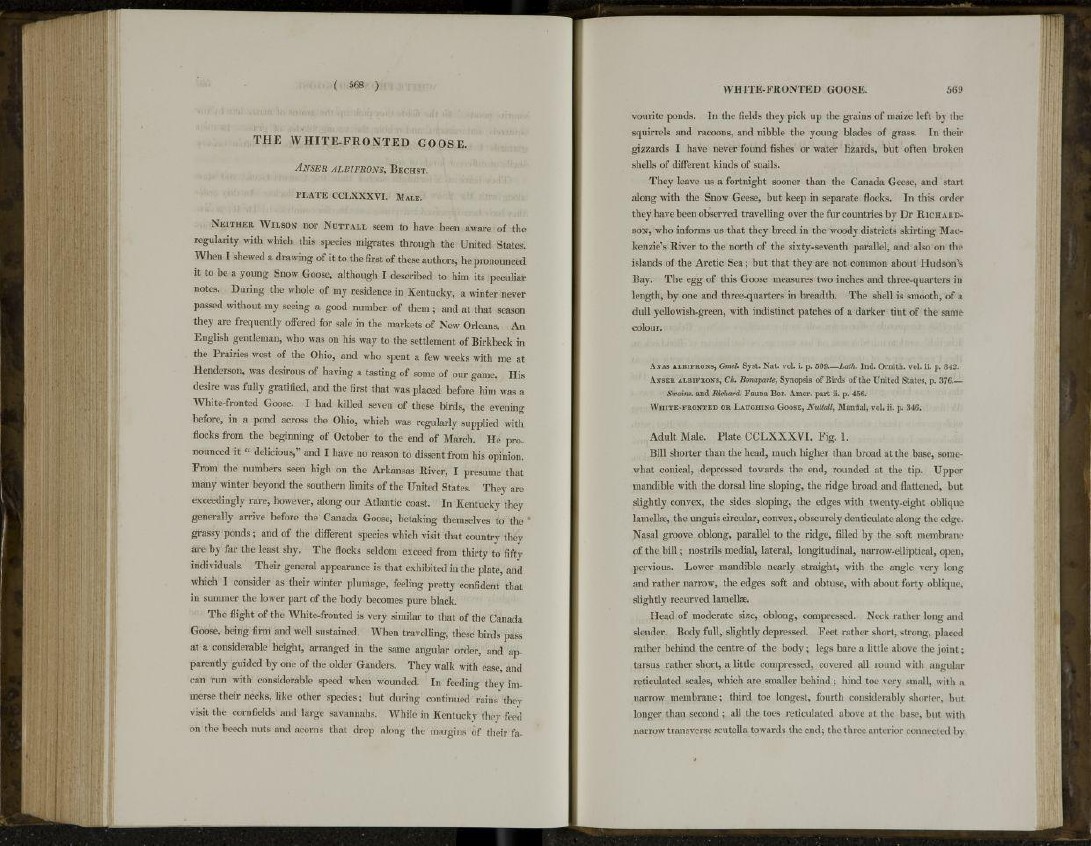
T H E W H I T E - F R O N T E D G O O S E.
ANSER ALBIFRONS, BECHST.
PLATE CCLXXXVI. MALE.
NEITHER WILSON nor NUTTALL seem to have heen aware of the
regularity with which this species migrates through the United States.
When I shewed a drawing of it to the first of these authors, he pronounced
it to be a young Snow Goose, although I described to him its peculiar
notes. During the whole of my residence in Kentucky, a winter never
passed without my seeing a good number of them ; and at that season
they are frequently offered for sale in the markets of New Orleans. An
English gentleman, who was on his way to the settlement of Birkbeck in
the Prairies west of the Ohio, and who spent a few weeks with me at
Henderson, was desirous of having a tasting of some of our game. His
desire was fully gratified, and the first that was placed before him was a
White-fronted Goose. I had killed seven of these birds, the evening
before, in a pond across the Ohio, which was regularly supplied with
flocks from the beginning of October to the end of March. He pronounced
it " delicious,'1 and I have no reason to dissent from his opinion.
From the numbers seen high on the Arkansas River, I presume that
many winter beyond the southern limits of the United States. They are
exceedingly rare, however, along our Atlantic coast. In Kentucky they
generally arrive before the Canada Goose, betaking themselves to the 1
grassy ponds; and of the different species which visit that country they
are by far the least shy. The flocks seldom exceed from thirty to fifty
individuals. Their general appearance is that exhibited in the plate, and
which I consider as their winter plumage, feeling pretty confident that
in summer the lower part of the body becomes pure black.
The flight of the White-fronted is very similar to that of the Canada
Goose, being firm and well sustained. When travelling, these birds pass
at a considerable height, arranged in the same angular order, and apparently
guided by one of the older Ganders. They walk with ease, and
can run with considerable speed when wounded. In feeding they immerse
their necks, like other species; but during continued rains they
visit the cornfields and large savannahs. While in Kentucky they feed
on the beech nuts and acorns that drop along the margins of their favourite
ponds. In the fields they pick up the grains of maize left by the
squirrels and racoons, and nibble the young blades of grass. In their
gizzards I have never found fishes or water lizards, but often broken
shells of different kinds of snails.
They leave us a fortnight sooner than the Canada Geese, and start
along with the Snow Geese, but keep in separate flocks. In this order
they have been observed travelling over the fur countries by Dr RICHARDSON,
who informs us that they breed in the woody districts skirting Mackenzie's
River to the north of the sixty-seventh parallel, and also on the
islands of the Arctic Sea; but that they are not common about Hudson's
Bay. The egg of this Goose measures two inches and three-quarters in
length, by one and three-quarters in breadth. The shell is smooth, of a
dull yellowish-green, with indistinct patches of a darker tint of the same
colour.
ANAS ALBIFRONS, GmeU Syst. Nat. vol i. p. 509.—Lath, Ind. Ornith. vol. ii. p. 842.
ANSER ALBIFRONS, Ch. Bonaparte, Synopsis of Birds of the United States, p. 376
Swains, and Richard. Fauna Bor. Amer. part ii. p. 456.
WHITE-FRONTED OR LAUGHING GOOSE, Nuttall, Manual, vol. ii. p. 346.
Adult Male. Plate CCLXXXVI. Fig. 1.
Bill shorter than the head, much higher than broad at the base, somewhat
conical, depressed towards the end, rounded at the tip. Upper
mandible with the dorsal line sloping, the ridge broad and flattened, but
slightly convex, the sides sloping, the edges with twenty-eight oblique
lamella?, the unguis circular, convex, obscurely denticulate along the edge.
Nasal groove oblong, parallel to the ridge, filled by the soft membrane
of the bill; nostrils medial, lateral, longitudinal, narrow-elliptical, open,
pervious. Lower mandible nearly straight, with the angle very long
and rather narrow, the edges soft and obtuse, with about forty oblique,
slightly recurved lamellae.
Head of moderate size, oblong, compressed. Neck rather long and
slender. Body full, slightly depressed. Feet rather short, strong, placed
rather behind the centre of the body ; legs bare a little above the joint;
tarsus rather short, a little compressed, covered all round with angular
reticulated scales, which are smaller behind ; hind toe very small, with a
narrow membrane; third toe longest, fourth considerably shorter, but
longer than second; all the toes reticulated above at the base, hut with
narrow transverse scutella towards the end; the three anterior connected by